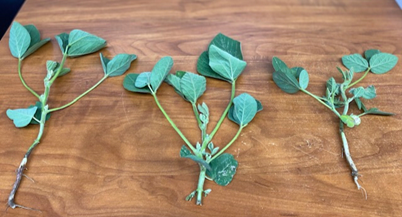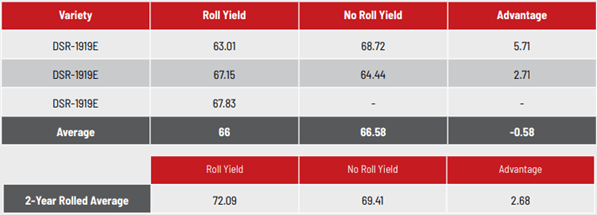2023 PAR (Product & Agronomy Research) Report: Soybean Rolling to Stimulate Branching for Increased Yield
BY Dairyland Seed Agronomy Team
Intentional damage to the terminal growing point of soybeans is believed to increase branching and produce more nodes from which pods may develop. These practices are often brought up at meetings anecdotally and some claim to have seen increases in yield.
We began this investigation in 2021 with a demonstration of mowing and rolling. Yield data was collected; however, no control data was collected.
In 2022, we performed this trial in Wabash, IN and Mt. Hope, WI. We continued this trial in 2023 at our Mt. Hope location. In those two years, we collected control as well as treatment data.
2022 EFFORTS EXPLAINED
Wabash, IN: DSR-3177E™ and DSR-3587E™ were planted on April 27th at 130,000 seeds per acre in 30-inch rows.
Treatments:
1. Untreated
2. Roll soybeans at V2-V3 growth stage
Mt. Hope, WI: DSR-2188E™ and DSR-2562E™ were planted on May 11th at 120,000 seeds per acre in 30-inch rows.
Treatments:
1. Untreated
2. Roll soybeans at V2-V3 growth stage

FIGURE 1: LEFT CONTROL, ROLLED, MOWED FROM MT. HOPE, WI PAR SITE
RESULTS
TABLE 1: 2022 SOYBEAN ROLLING RESULTS FOR MT. HOPE, WI AND WABASH, IN

TABLE 2: 2023 RESULTS FROM MT. HOPE, WI, ROLLED

TABLE 3: 2023 RESULTS FROM MT. HOPE, WI, MOWED

CONCLUSION
In evaluating this practice over the last three seasons, we have seen an overall yield increase. There exists differences year over year and variety to variety. 2021, our demonstration year, compared to other soybean yields on the research farm the mowing and rolling concept showed promise. With that knowledge in hand, we continued in 2022 and 2023. One key management practice was to perform this treatment during the heat of the day while the plant was limber to avoid breaking the plants off at the soil line. The results indicate an average of all rolled treatments to an approximately 2.68 Bu/A advantage to rolling. Yields ranged from a negative 5.4 to a positive 11.5-bushel difference. Individual results by variety show a large range in the advantage to rolling. Depending on the natural branching of the variety, this would be logical. With one year of comparative data in 2022, there seemed a bit of inconsistency. However, that lack of consistency indicates that other yield determining factors, such as weather, could have a larger play than the rolling treatment. As we compiled two years of information together, the data became more conclusive on the advantages of rolling soybeans.
We also evaluated mowing and had minimal response on a limited database. Soybeans respond to the mechanical damage of rolling and mowing by branching and compensating for the lost meristematic or growing point tissue. The loss or damage to the growing points on the soybeans triggered the soybeans to grow through the secondary nodes, which causes branching and the possibility for more pods.

Brian Weller
Western Region
507.456.3034

Rod Moran
Western Region
507.456.3034

Dan Ritter
Central Region
219.863.0583

Branden Furseth
Northern Region
608.513.4265

Mark Gibson
Eastern Region
260.330.8968

Amanda Goffnett
Eastern Region
989.400.3793

Ryan Mueller
Eastern Region
989.400.3793
